Skills, Endurance, and Majesty:
A Paddling Expedition in Cape Breton
By Kerry Kirk Pflugh. Photos by Troy Siegel and Kerry Kirk Pflugh.
The driving rain and low atmosphere created a fog-like effect as I looked at the distant shoreline. The waves crashed around me and the sudden force 6 winds were carrying me further from my companions, who were in their own struggle with the wind and waves. I was losing sight of White Rock, our destination on the opposite shore of the Bay of St. Lawrence, as the wind and waves swept me out into the Gulf of St. Lawrence. It was then I remembered my skeg was partially down. I lifted it and instantly, I was able to bring my bow around into the wind and get a ferry angle. With all my strength, I battled the squall and made my way back into the harbor and to the White Rock where my companions were anxiously waiting for me.

Like every trip I have ever embarked on, the trip to Cape Breton had been planned and discussed for more than a year. Debbie, Troy, and I decided that Cape Breton would be our destination for our next adventure even before we had completed our Maine trip. With its famous remote mountain range, the historic Cabot Trail, and a promise to paddle with whales, this seemed like the perfect blend of great paddling, history, and a wild and rugged coastline.
The plan was to launch from Pleasant Bay and paddle over the next four days to Cabot's Landing. We built in extra time in the event that foul weather grounded us. Research told us that this stretch of water had the potential of being very rough and unpredictable, depending on the weather. We spoke to experts and local guides including Scott Cunningham, who wrote the book on paddling in Nova Scotia. We learned the prevailing winds, looked at weather history for the area, and studied maps and navigation charts. We even took some rough water training to brush up on skills, just in case.
All of this was useful and valuable, but in the end it's good judgment, accurate risk assessment, and dealing with the conditions you find yourself in that makes or breaks a trip. Even with all the planning and preparation, conditions happen and you must deal with them. And so it would be for this trip.
We arrived in Pleasant Bay, a small, humble coastal town on the Cabot Trail, after a two day drive from the New York/New Jersey area. The coastline is rocky and rugged, but the mountains reaching up to the sky are green and pastoral. Horses range freely and, we would learn, make themselves quite at home in your campsites.
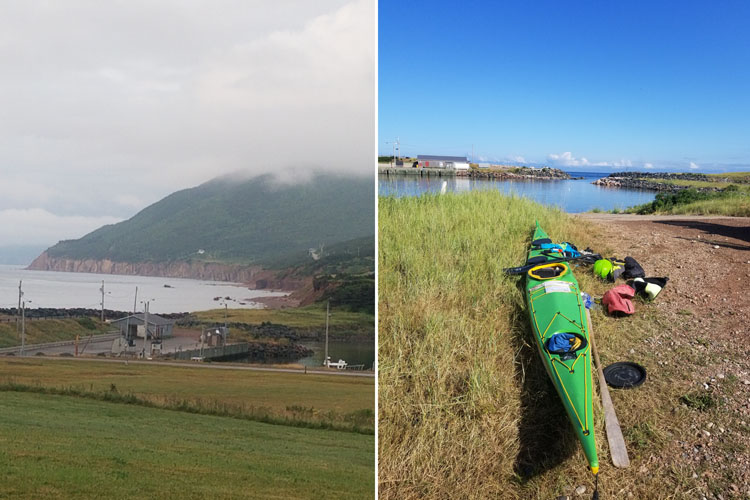
L: Pleasant Bay. R: Loading for departure.
It was late when we arrived and getting dark. It had been raining most of the day and we decided that instead of doing the necessary shuttle in the dark, we would arise early the next morning to drop a car at Cabot's Landing, our pullout on the other side of the mountains.
The drive over the mountains the next day was nothing short of magnificent and terrifying. The narrow winding roads reached up to the sky as we wove our way around and up, and then down the other side of the mountain range to Cabot's Landing. The mountains were thick with stately spruce trees. Streams seemed to flow from their depths, traversing down mountainsides, through valleys, and emptying into the sea. In the valleys, the landscape was pastural, dotted with small farms and hamlets. We passed numerous hikers and bikers looking for that special trail or road challenge on the Cabot Trail.
Cabot's Landing is a lovely, well-kept Provincial Park with an expansive sandy beach. Standing on the shore, looking out on the vastness of the North Atlantic, gave me pause. A paddler would be completely vulnerable to the elements should a storm or squall come through. I hoped that conditions on our journey would be kind to us, but I had every expectation that we were about to embark on an adventure of endurance and a test of our skills.
Pleasant Bay was a-bustle upon our return. Tourists gathered to board several whale watching boats that moor there. Other visitors walked along the pier in hopes of spotting whales swimming by. It took about an hour to load our gear and make sure we had what we needed for the return shuttle. We left a float plan with one of the whale watching companies and exchanged contact information. The owner, advised that we stay off the water the next day because winds were predicted to be about 40 miles an hour. We had already decided that Tuesday would be our off water day, but we were grateful for the advice and asked about future forecasts. "Too early to tell," was the answer we received from everyone we asked.
We launched at around 11 a.m. The paddle to Pollett's Cove was about nine miles. Conditions were perfect - light wind, sea state textured but gentle, sunny, and warm.
I was conflicted about where I wanted to paddle. Hugging the shoreline, I would have the opportunity to see the beautiful rock formations or maybe a sea cave, but off shore I might see whales. For the first half of the trip I stayed near shore. I was not disappointed by this decision. The surrounding green mountains eroded to a sandstone rock face that dropped into the sea. The coast was littered with cobble stones guaranteeing a bumpy landing should one need to pull off the water.
Just as we neared Pollett's Cove, Troy and I got hailed by Debbie and the whale watching captains. They advised we paddle about a mile off shore where we would run into a pod of whales. Without hesitation, we paddled into the Gulf and right into a pod of whales.
On the drive up the mountains from Cheticamp to Pleasant Bay, Debbie and I had seen two whales swimming up the coast. Even from our distant vantage, we could see they were enormous. We speculated whether they were or minke or fin whales. Remembering their size, I was a little nervous about what whales we might see. As it turned out, they were pilot whales (genus Globicephala). Pilot whales are similar in features to Belugas, except in color. They are about 19 feet long and grey or black in color. I immediately relaxed and enjoyed watching them dive and swim under our kayaks and all around us.
There must have been plenty of prey like squid or fish around, because there were pod upon pod of whales swimming and diving in the area. As one group pulled away, we caught up with another. At one point a cow and her calf swam in amongst our three kayaks. The calf broke the surface and literally looked around at each of us before diving. It was awesome!

Pilot whales.
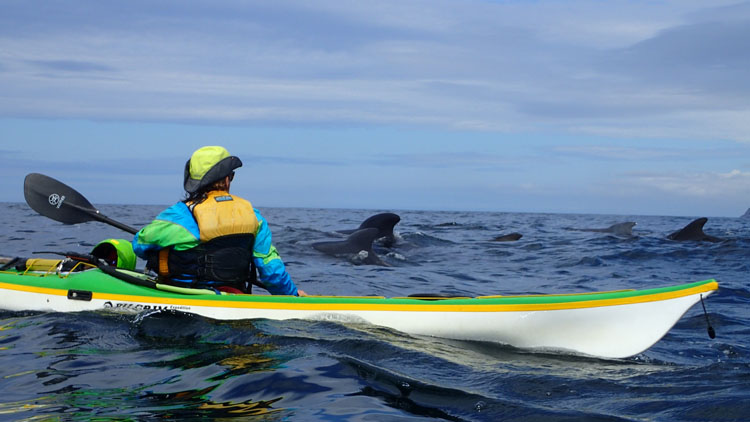
Pilot whales with Kerry.
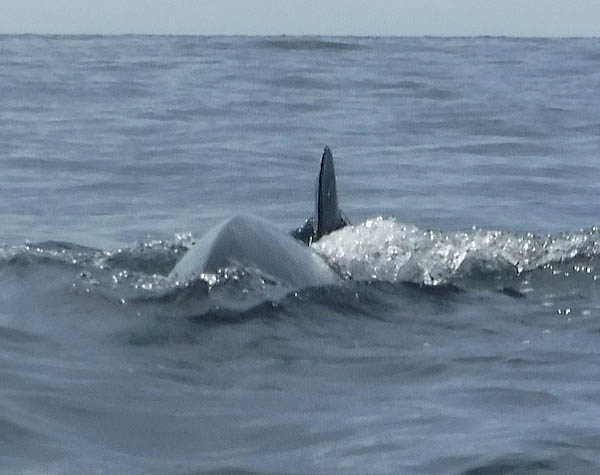
A young whale tries to get "up close and personal."
We played with the whales for about an hour, then, little by little, the pods pulled away and soon the water was quiet again. We waved goodbye to the whale watching boats and paddled to Pollett's Cove. It was long past lunch and we decided to take a break. Once on shore, we talked about paddling on, but in the end decided to stay at Pollett's Cove for the next two nights and hike the next day, while we waited for the predicted storm and wind to pass.
Pollett's Cove was every bit as beautiful as was described by numerous writers and paddlers. However, despite its limited accessibility - either by foot or boat, it was quite busy. More than half a dozen campers had hiked in for an overnight. We chatted with several folk, about where they were from and where they were headed. Most had heard of Pollett's Cove's beauty and wanted to experience it firsthand. Even though the site was crowded with campers, we decided to stay and make camp.
A fresh water stream flowed from the mountains through the valley and out to the Gulf. Green pastures, and rolling hillsides with free ranging horses abounded. Throughout the cove you could see makeshift fences and barricades, presumably to keep the curious horses away from tents and food.

Receding headlands between Pleasant Bay and Pollett's Cove.
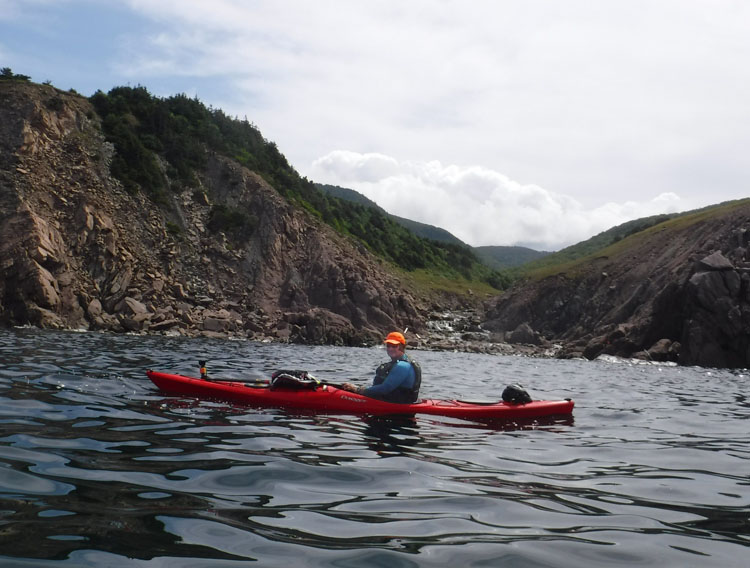
Troy in front of a gulch and its stream that we passed.
Because of the approaching storm, we looked for a site that would be somewhat sheltered from the wind. We tucked in behind a hillside on the north side of the cove, away from the other campers, who were nestled against the hill across the stream. As we put up our tents and prepared our meal, the sun was sinking rapidly. We grabbed cameras and climbed to the top of the hill just in time to see it dip into the Gulf. It left a rose, orange, and purple sky in its wake and we watched until all color faded and gave way to deep purple, then blue, then black.

L: Evening sun at Pollett's Cove. R: Our tents tucked in behind a hillside.
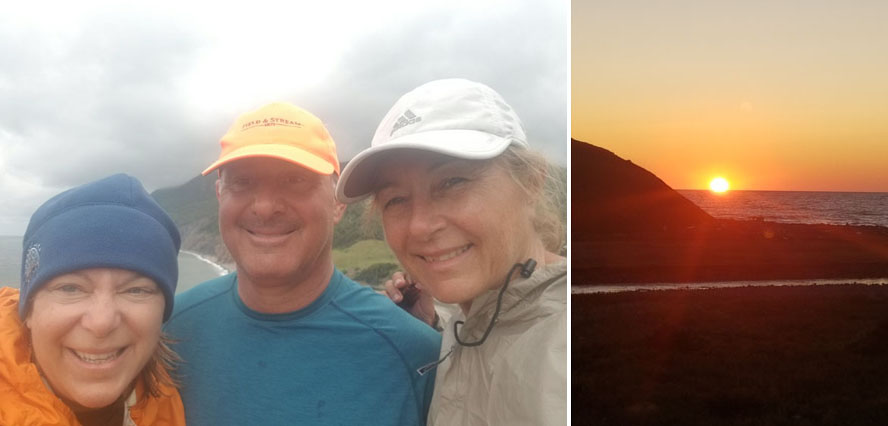
L: Kerry, Troy, and Debbie. R: Sunset over the ocean.
Once in our tents, we settled in and hunkered down for the wind and rain. Somewhere in the middle of the night, it hit. Pouring rain pelted us, followed by intense wind. My tent bent flat, but never gave way. The rain lasted for just a short time, but by dawn the wind was still blowing, just not as intensely as it had overnight.
As we made breakfast, we watched the campers on the other side of the valley pack up and one by one head out. Soon we were alone with the horses. After breakfast, we made sure our tents and other belongings were secure and went for a hike. On top of the mountain ridge, you could see for miles. The Gulf was choppy and white caps dominated the gray and angry sea. I wondered if the sea would quiet down once the wind had stopped or if the waves and chop would persist.
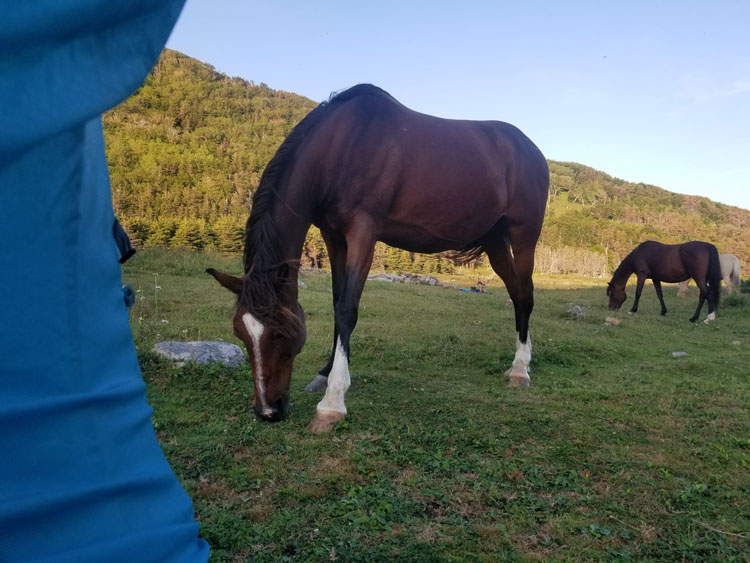
We woke to a sunny day and the sound of horses chomping at the thin turf.
By the time we returned to our camp site, the wind had subsided a bit more. We began making plans and packing for the next day. It was decided we would leave early and paddle the 12 miles to Meat Cove, arriving before the predicted afternoon winds picked up.
Wednesday dawned bright and sunny, but a bit breezier than expected. Waves were crashing on the rocky beach as we launched into a choppy and confused sea. It became immediately evident that the wave height was bigger than we had realized and the waves were breaking near shore. To prevent a spill, we paddled about a mile off shore. For the next couple of hours, we paddled in three- to five-foot waves with a following sea. On occasion, a rogue breaker would sneak up on us, but we managed to avoid being rolled.
At one point, one of my companions felt queasy. We rafted up and shared some ginger and discussed the possibility of attempting a landing on one of the rocky little beaches we were passing. In the end, we decided that the wave height and intensity of the breakers would have made for a precarious landing and difficult relaunch. We pressed on until just before Meat Cove, when the seas quieted and we saw a chance to take a break safely. With a little rest and some food, we relaunched without incident and paddled the remaining two miles to our destination.
Meat Cove is a busy public beach and campsite. The cabins and tent sites were located on top of the hill far above the beach. We decided that we would ask permission to camp on the beach because the idea of hauling gear and kayaks to the top of the hill to the designated campsites was not at all appealing.
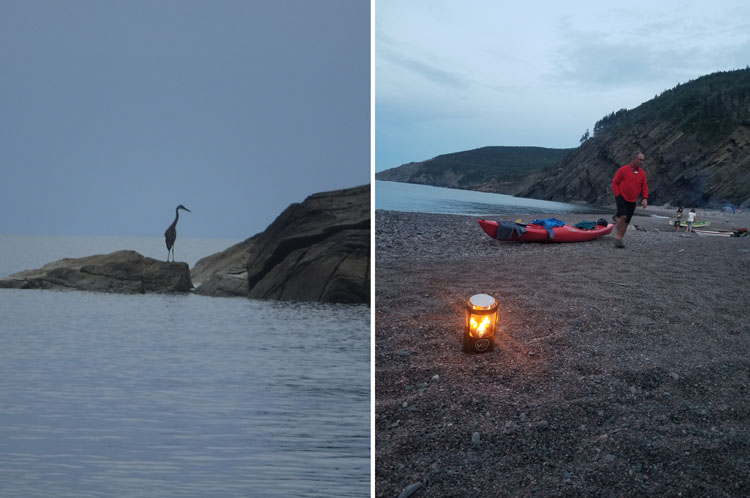
L: A heron stands silhouetted against the dusk in Meat Cove. R: Candle lantern and eveninmg stillness on the beach at Meat Cove.
The cove was bustling with activity and the small restaurant on top of the hill was busy with tourists and campers. It was warm and the beach was filled with families and children playing and swimming. Dressed in our dry suits and paddling gear complete with radios, tow ropes, and helmets, we looked like we have returned from some grueling expedition - completely overdressed and out of place. People just stared as we landed.
With permission to camp on the beach granted, we took advantage of the restaurant and showers and then made camp for the night. Little by little families left the beach, until finally, it was just Debbie, Troy, and I. We prepared for dinner and built a small fire from the stray pieces of driftwood we found. About this time I realized I wasn't feeling well. I decided to skip dinner and went straight to bed, hoping that by morning whatever it was would pass. Unfortunately, that plan failed, and I was up all night with stomach ailments.
By day break, I was tired and weak and not at all hungry. We had a five mile open water paddle facing us and another two or three miles to our campsite. A rain storm was predicted for the late morning with the following day predicted to be another high wind day. Given the circumstances, I felt I needed to push myself to make the passage and get settled ahead of the storm.

Leaving Meat Cove with the five-mile open water crossing ahead.
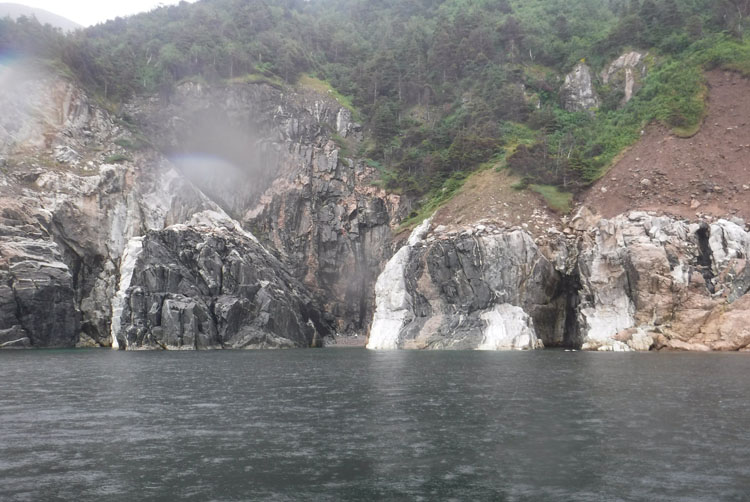
White Rock, a massive quartz intrusion and our goal across the Bay of St. Lawrence.
We launched as the day dawned grey and deeply overcast. Debbie and Troy wolfed down power bars and we packed at record speed. The cove was glass-like, not a ripple broke the surface. As I paddled, the fresh air seemed to pick me up a bit and I felt I would be okay. However, as we made our way into the Bay of St. Lawrence, the wind picked up and the sea state built, becoming textured and confused. About half way to White Rock, an unexpected squall hit. The three of us were blown in different directions and I found myself alone, battling to remain in the Bay. The driving rain was coming down so hard, it felt like hail and the wind was unrelenting.
As I was being carried out of the Bay into the Gulf, I remembered my skeg was partially down. I lifted it and was able to maneuver my bow into the wind and get a ferry angle that carried me back into the Bay and across to where my companions were waiting for me. At this point, I was exhausted, but also pleased that I had managed the squall and was safely reunited with my companions. The pouring rain had not let up, so I pulled my cagoule out of the day hatch for additional protection.
We discussed our options - going back, paddling into the harbor, or continuing. Realizing we were just two miles away from our pull out, we decided to continue. As we paddled past sea caves and unique rock formations and spires, we were joined by a pod of seals. At times they were skittish and at other times, brave enough to be within two feet of our kayaks. They were completely unaffected by the wind, waves, and rain.
We rounded Cape North and passed the lighthouse at Money Point, the feature that indicated our campsite was near. By this point, we had endured at least two more squalls and whatever strength I had left had vanished. I called to my companions for help. We rafted up and they insisted, despite my stomach upset, that I eat and drink something. I did so with great trepidation. Knowing that I was completely out of juice, I asked to be towed. About five minutes into the tow, I started to revive and reached for another power bar that I had placed in my pocket. After another ten minutes, I was paddling while in tow. The food and water had revived me enough so I could continue.
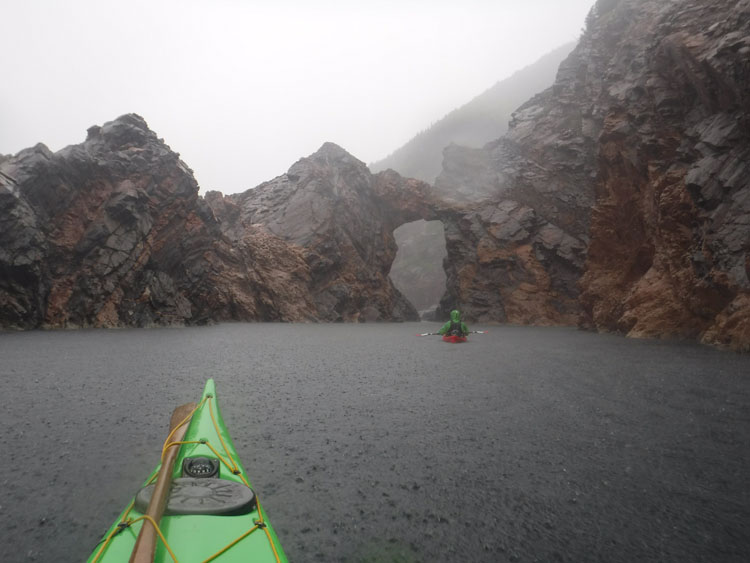
A sea arch looms ahead as we paddle towards Cape North.
We looked for the description of our pull out, but after paddling four miles, we knew we had missed it. The weather was continuing to be unfavorable, although the intensity of the wind had died down. However, the sea state was still choppy and we were all tired and anxious to take a break. We consulted our maps and GPS and Troy indicated we were less than a mile to the Gulch, the location of a beautiful waterfall and possible pullout. We paddled until we reached the falls. The rain had by now subsided significantly and the winds remained tolerable, but the sea state seemed to be building. Troy inspected the possibility of using the Gulch as a campsite, but after landing and walking around, he decided that it was very wet and with waves from the North Atlantic crashing into the small cove, we figured it would be best to find something else. By this point, we were running out of options. The next safe pull out was Cabot's Landing, which was scheduled to be our final stop the next day. Apparently, in our pursuit of a landing, we had paddled well beyond our planned pull out.
Troy estimated that we were only four miles away. We decided to go for it. In the distance, I could see the beach. Waves were crashing against the rock wall of North Mountain and the sea state continued to be big and confused. Fortunately, the wind and rain had stopped and with our destination in site, the only thing I could think about was how to safely land in the crashing surf.
About a mile from the beach we paused to put on our helmets. We discussed the best approach for a landing in big breaking waves and then made our way to shore. As we got closer, the crashing waves seemed to subside. Perhaps it was the contour of the land, or the slightly sheltered configuration of the cove, but the landing was anti-climactic in comparison to the day on the water.

On the beach at Cabot's Landing. Note the nearly non-existent surf.
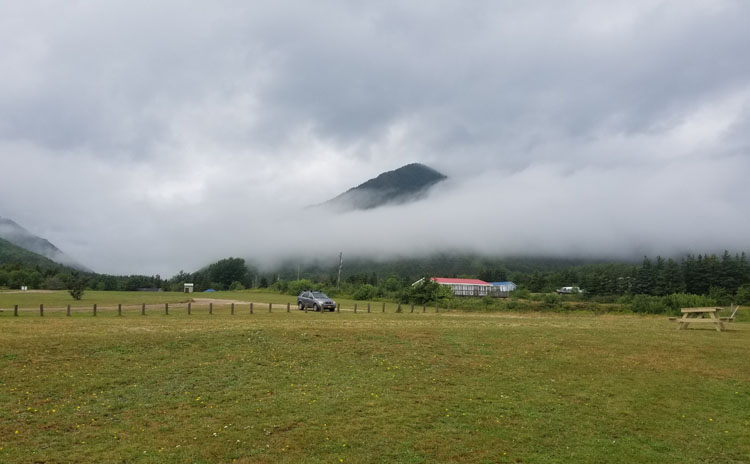
The beach and adjoining park were not in great demand this rather dreary day.
All three of us rejoiced by kissing the sand and laying there for several minutes calming our nerves and getting our land legs. It felt like we had been on the water for days. In fact, it was only early afternoon. Considering the squalls, wind, and waves, we had made excellent time covering the 15 miles from Meat Cove to Cabot's Landing.
It was a paddle trip for the record books - a test of endurance, strength, skills, fear, anxiety, and team work. Conditions ranging from benign to challenging with five foot waves, following seas, breakers, squalls with driving rain making visibility nearly zero; and winds gusting to 30 knots with no place to land.
There continues to be much to process about our decisions. The trip, however, definitely solidified my confidence in and knowledge of my skills; the importance of eating and drinking even when not hungry; the value of good research, planning, and preparation, and the absolute gravity of choosing good and skilled paddling pals that you can depend upon to join you on eventful expeditions.

|
Kerry Kirk Pflugh: Kerry is Director of the Office of Local Government Assistance at the New Jersey Department of Environmental Protection, the direct line between the DEP and all municipal, county, and local governments. She is an enthusiastic sea kayaker, expeditioning from Newfoundland to the Adirondacks to Alaska. Kayaking has taken Kerry to places she never dreamed she'd see. She has met extraordinary people and enjoyed sharing her adventures with friends. She also enjoys writing about her travels in the hopes of inspiring others to wander the waters of the world..
|
